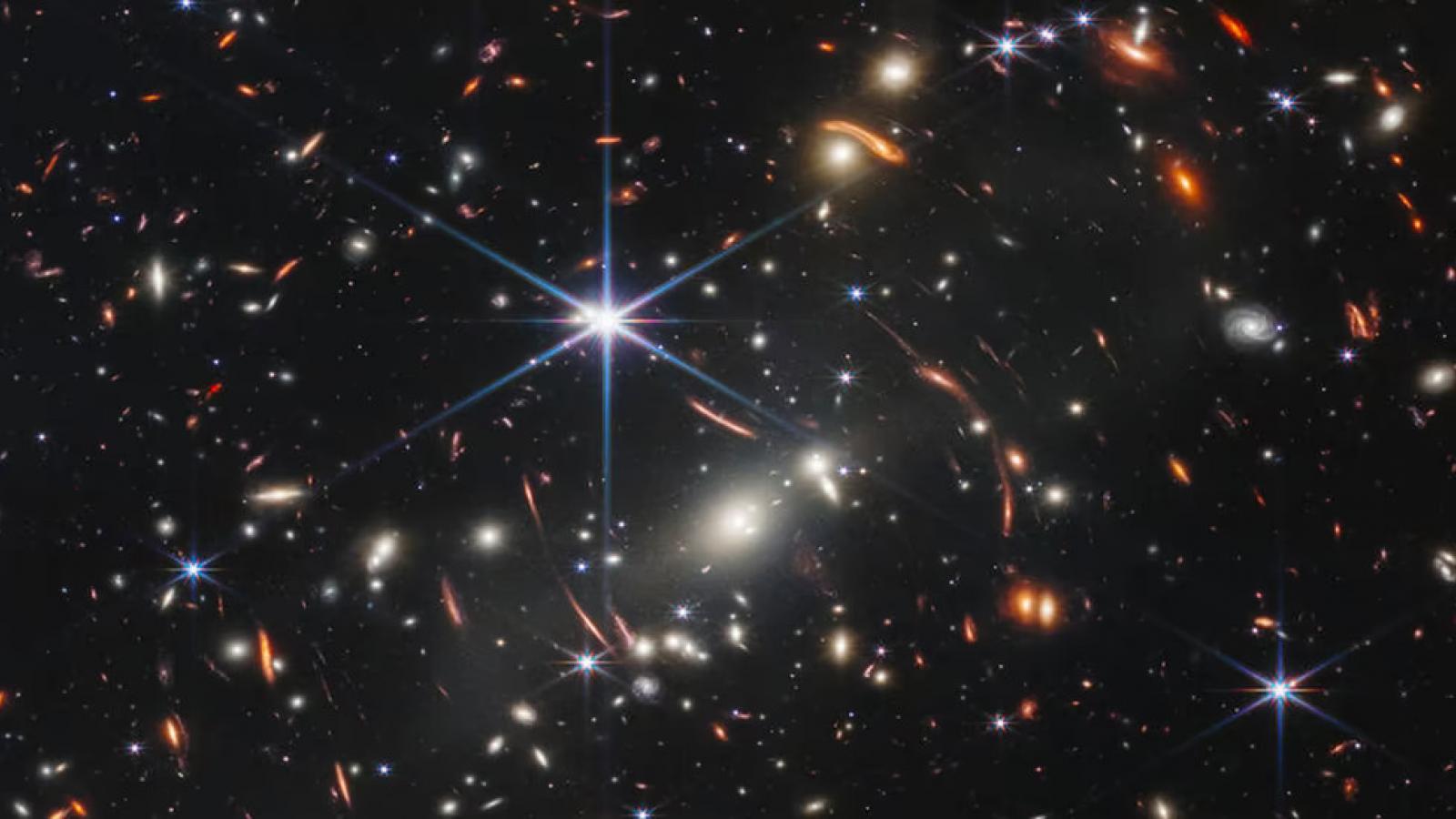This Is the Picture Astronomers Have Been Waiting For

There are so many galaxies in here.
Those bright, spiky points are nearby stars, but every tiny oval, every gleaming blob is a distant galaxy, a swirling creation brimming with stars and dust and planets. Some of the galaxies in the foreground are part of a cluster called SMACS 0723, so massive that its gravity warps the light coming from other, more distant galaxies. The effect magnifies their brightness, bringing thousands of them out of the darkness. The cosmic gems fill up every corner of the frame, each one captured the way it appeared billions of years ago, when the starlight left its shimmery edges and began wafting across the universe.
The image, released today, was taken by the world’s newest space observatory, the James Webb Space Telescope. It is the first real snapshot from the mission, which launched more than six months ago and currently orbits about 1 million miles from Earth.
The picture is sparkly and beautiful, a great choice for a computer background. It is also, more important, an entirely new view of the universe. The light from the galaxies in the foreground left 4.6 billion years ago, and the light from the galaxies beyond those, even longer. All this light has been captured in unprecedented detail by the most powerful space telescope in history, making this one of the deepest, most high-resolution pictures of the universe that humankind has ever taken.
Astronomers call this kind of view a “deep field”: a picture of one spot in space, made with long exposure times so that the instrument can really bask in any incoming light. Remember Hubble, and that glorious deep-field image from the 1990s, sparkling with thousands of galaxies? The Webb telescope was designed to spot celestial objects that are about 100 times fainter than the ones Hubble can detect. Today’s image isn’t as deep as Webb can go, but astronomers on the Webb team are still surprised at how good it looks, and they’ve realized something extraordinary about the observatory’s capabilities. Just about every image Webb takes of a given cosmic object is going to count as a deep-field image, a snapshot from previously unreachable depths, the background twinkling with faraway galaxies that the telescope just happened to catch. And every new image has the potential to become our deepest view yet.
The image released today is, on a practical level, proof of mission success for NASA and its partners in this ambitious effort, the European Space Agency and the Canadian Space Agency. This is a bunch of space agencies shouting to the public: Look, this $10 billion space telescope that we’ve spent more than 25 years working on—it works! It works beautifully. But on a deeper level (sorry) the image represents something else, a cosmic leveling up of sorts. Here we are, on this little ball of rock in a boundless universe, and we have managed to glimpse the universe as it was billions of years before we even existed. We have stretched our perception of the universe from the night sky to the planets, to other suns and other galaxies, and soon we’ll catch the light that’s even older, even farther from us—closer to the big, mysterious moment when the universe began.
This kind of deep-field science is a fairly new discipline. Before Hubble launched in the early 1990s, astronomy was done like this: Pick the star, galaxy, or other cosmic object you want to study, and then point a telescope in its direction. “You would never take your telescope and point it at a very blank patch of sky, because that would be a waste of telescope time,” Caitlin Casey, an astronomer at the University of Texas at Austin, told me. That is exactly what astronomers told Bob Williams in 1995, when Williams, then the director of the institution that managed the Hubble Space Telescope, decided to do just that. Williams thought that if he aimed Hubble at nothing in particular for many hours straight, the telescope would turn up something interesting; after all, the longer a space telescope stares in one direction, the more light it detects. His hunch was correct, and the effort produced Hubble’s famous deep field, a view of some 3,000 galaxies that stretched billions of years back in time.
Hubble has since produced multiple deep fields, reaching the limit of its capabilities. By now, the 32-year-old telescope—which observes the cosmos in visible and ultraviolet wavelengths, with just a hint of infrared—has seen as far back in time as it possibly can. Hubble can’t spot the most distant stars and galaxies in the universe; the glow emanating from those objects departed as visible light, but it has been traveling across space for so long that it reaches Earth as infrared. But infrared light is Webb’s specialty. Casey and other astronomers have already secured time on Webb to do what Williams did nearly 30 years ago. According to Casey, if Hubble’s deep field could fit on a sheet of paper, Webb’s equivalent would be a 16-by-16-foot mural.
Webb is meant to observe more than just ancient stars and galaxies. The telescope can study nearly everything from the planets of our solar system to star-forming regions millions of light-years away. Unlike visible light, infrared can pass through cosmic dust, which means Webb will detect objects that are invisible to Hubble. And Webb is so sensitive, Casey said, that even when it’s not looking for a bunch of faraway galaxies, they’re bound to photobomb. “No matter where you look in the sky, [even] if you’re looking at a planet in the solar system, you’re going to see these galaxies in the background,” Casey said.
NASA is scheduled to release more Webb images tomorrow, marking the beginning of the mission’s science operations. Scientists are giddy, eager to dive into the data behind the pretty pictures. Some astronomers’ excitement is tempered by the controversy surrounding Webb’s namesake, a former NASA administrator who some say was complicit in discrimination against LGBTQ government employees in the 1950s and ’60s; NASA has conducted an investigation into the administrator’s past, but so far has refused to consider renaming the mission. Still, the general mood in the astronomy community is much more buoyant than it was in December, when Webb was still on the launchpad on the coast of South America. I remember sitting in the mission-control room in French Guiana and talking to Pierre Ferruit, the Webb project scientist at the European Space Agency, who wore a nervous expression just like everyone else in town. Back then, no one could have predicted that Webb would move so seamlessly through the extremely complicated deployments involved in its first several months in space.
When I checked in with Ferruit over Zoom a few days ago, he was beaming with relief. “We were afraid of the launch, we were afraid of the deployments, and everything went smoothly,” Ferruit said. He had seen the first batch of images, and they were fantastic. Now, at last, it’s time for astronomers to let go of their worries about the mechanics, and focus on what the telescope can show us about the wondrous and mysterious universe surrounding our little ball of rock.
Marina Koren is a staff writer at The Atlantic.
- Se connecter ou s'inscrire pour publier un commentaire
- 26 vues
Connexion utilisateur
Dans la même rubrique
06/12/2025 - 12:25
13/11/2025 - 10:20
de Philippe RICHARD
27/10/2025 - 12:20
URGéo-URBATER, Université d'État d'Haïti, Agence Kannh et le bureau d'étude et de conseils TCGNRG
22/10/2025 - 19:03
16/09/2025 - 15:48
Commentaires récents
Didier Laguerre (PPM) lance sa campagne électorale
Albè, non, je n’ai pas oublié mais...
Frédéric C.
21/12/2025 - 08:56
...maintenant ça fait "système". Une fois: on peut laisser le "bénéfice du doute"... Lire la suite
Pèsonn pa ka blijé zot ay lakay Trump !
Man té kèy alé pli lwen :
Frédéric C.
21/12/2025 - 08:47
...Fòk pa alé la ba-a, menm si nou anvi wè New Orléans, Kongo Square, épi tout Lwisiyann-la ki sé Lire la suite
Didier Laguerre (PPM) lance sa campagne électorale
tous azimuts
abcx
20/12/2025 - 19:34
Existe-t-il encore des partis politiques en Martinique ? Lire la suite
Didier Laguerre (PPM) lance sa campagne électorale
MEMOIRE COURTE ?
Albè
20/12/2025 - 11:04
As-tu oublié qu'aux dernières législatives, Carole avait appelé à voter au second tour pour la so Lire la suite
Didier Laguerre (PPM) lance sa campagne électorale
C'est difficile de savoir ce qu’on peut...
Frédéric C.
20/12/2025 - 10:47
...souhaiter. Lire la suite
Top 5 des articles
Aujourd'hui :
- Entre assassinats avec armes à feu et accidents de la route, assistons-nous à un suicide collectif ?
- Centenaire de la naissance de Frantz Fanon : "l'esprit-mendiant arrogant" contre "l'esprit-micro-état"
- Pèsonn pa ka blijé zot ay lakay Trump !
- « Dégage, rentre chez toi pour construire des toilettes ! » : Le dérapage raciste assumé de l’Ukrainienne Alla Poedie, consultante LCI
- Didier Laguerre (PPM) lance sa campagne électorale
Depuis toujours :
- Tous les présidents et premiers ministres de la Caraïbe sont vaccinés
- L'intolérable appauvrissement intellectuel et culturel de la Guadeloupe et dans une moindre mesure de la Martinique !
- LETTRE OUVERTE AU 31ème PREFET FRANCAIS DE MARTINIQUE
- L'arrière-grand-père maternel de Joan Bardella était...algérien
- Les triplement vaccinés contre le covid ne bandent plus





